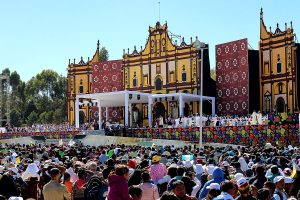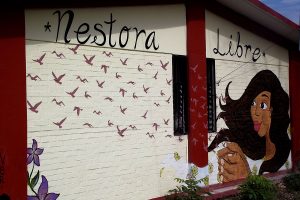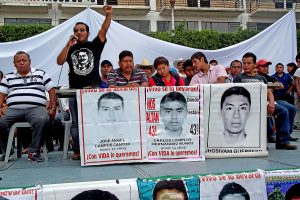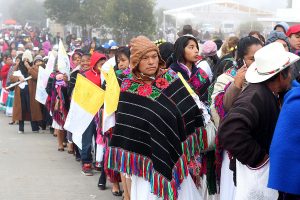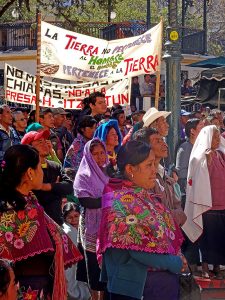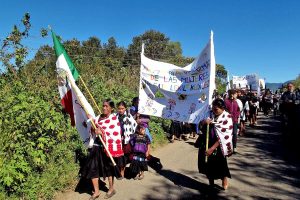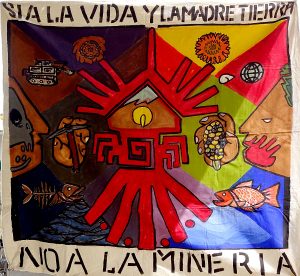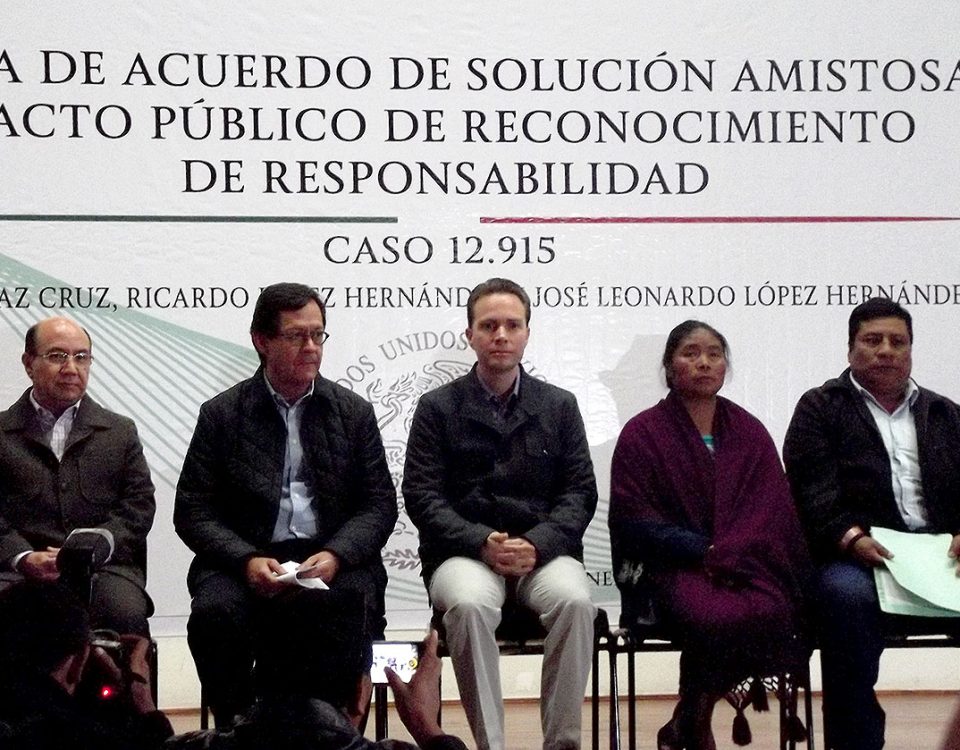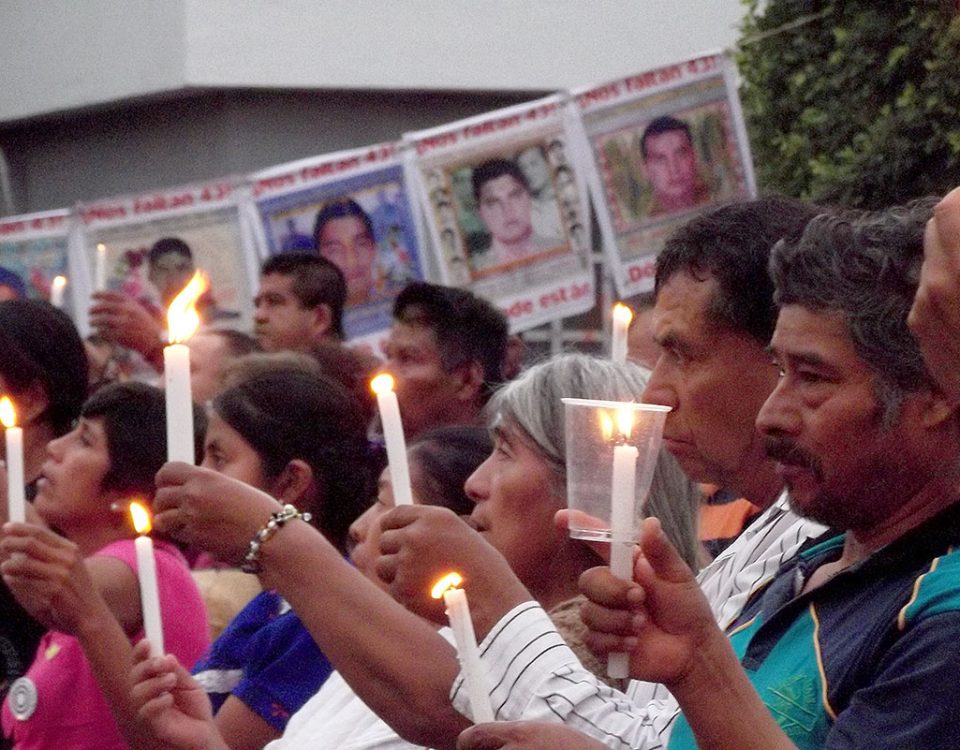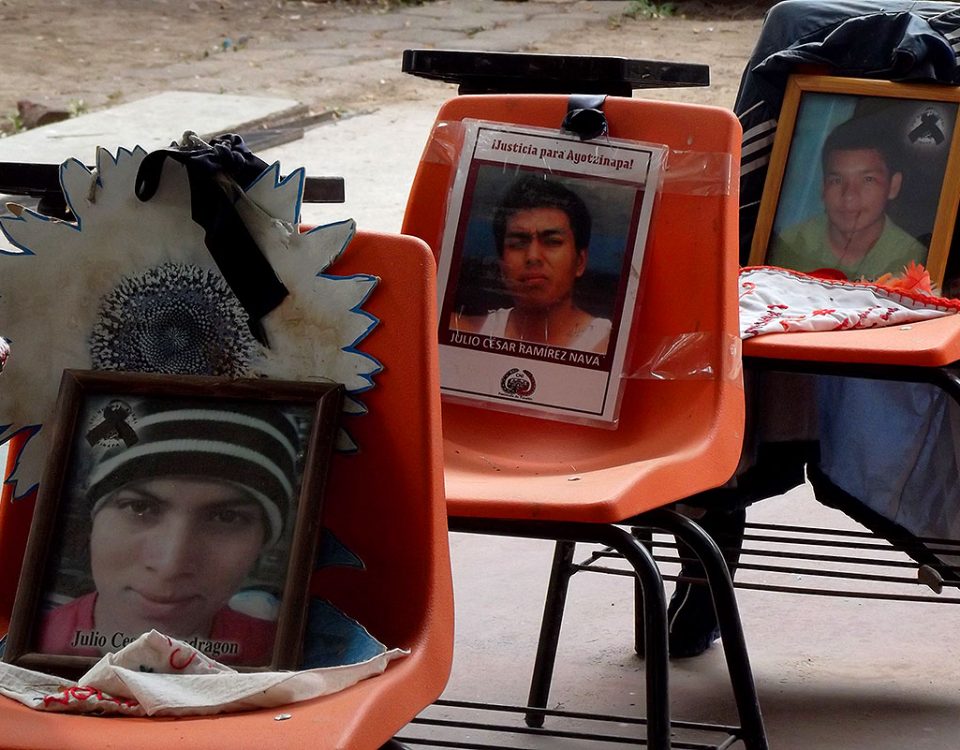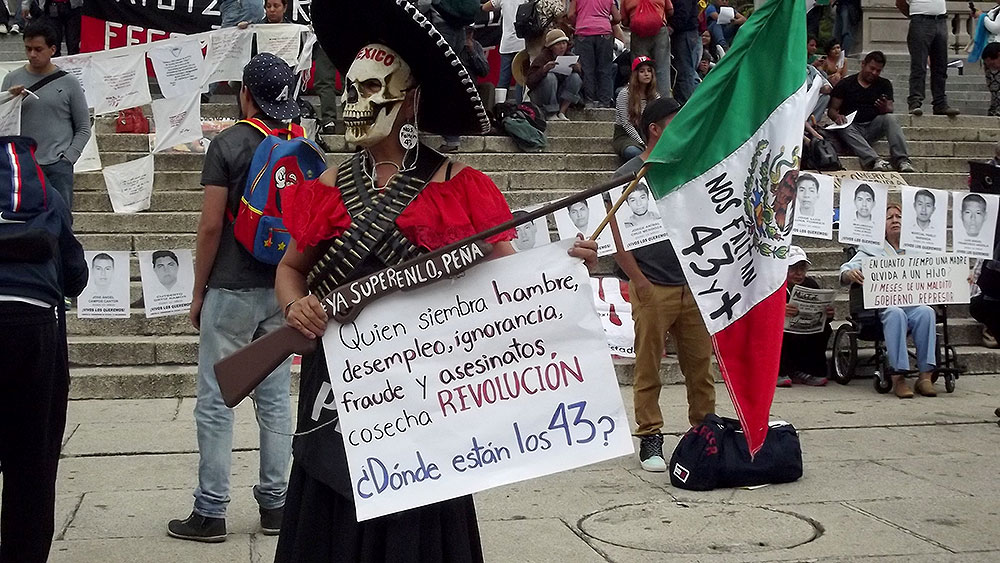
2015
02/05/2016
FOCUS: WHERE ARE THEY? The Situation of Forced Disappearance in Mexico
02/06/2016At the beginning of 2016, two topics took up the forefront of the national media: the arrest of Joaquin “El Chapo” Guzman”, founder of the Sinaloa cartel, who had been on the run since July 2015, and the visit of Pope Francis to Mexico from February 12th to 17th. The re-capture of “El Chapo” was widely celebrated by the Mexican Government. Nevertheless, according to the Attorney General of the United States, although it represents an “assertion of law enforcement”, Guzman was no longer an active player and the infrastructure of the Sinaloa cartel remained intact.
Pope Francis’visit disappointed those who wanted more explicit references to the problems that currently afflict the country. Although he did not refer to specific facts, like the forced disappearance of the 43 students of the Normal Rural School of Ayotzinapa in Guerrero in 2014, he made declarations that were quite clear for those who wanted to listen. For example, in Mexico City, he stated before President Enrique Peña Nieto and his invited guests: “each time we seek the path of privilege or the benefit of the few in detriment of the common good, sooner or later life in society becomes fertile ground for corruption, drug trafficking, the exclusion of different cultures, violence and even human trafficking, kidnapping and death.” In Juarez, he criticized the economic model that “advocates the greatest amount of profit possible, at any cost and immediately (…) causing the exploitation of workers as if they were objects to use, dispose of, and dismiss.”
The places he visited in Mexico demonstrated his sensitivity to a number of subjects: the State of Mexico with its high numbers of femicides; Juarez, known for the same reason, for exploitation in assembly plants (maquiladoras) and for being a border zone with the United States; as well as Michoacan, highlighted for violence related to organized crime. In Chiapas, religious celebrations in indigenous languages were formalized through papal decree. Another act, with little coverage, was the visit to Samuel Ruiz Garcia’s grave, who was bishop of San Cristobal for 40 years and a polemic figure in the Catholic hierarchy at the time. .
Reports continue to reprobate Mexico over matters ofhuman rights
In previous publications we have reported multiple critical reports from international organizations such as the United Nations Organization (UNO) or the Organization of American States (OAS), regarding the issue of human rights in the country. In January, reports were published from International Transparency (IT) on the issue of perception of corruption, and from Freedom House on the issue of freedom of expression, both of which reprobated Mexico.
A certain refusal of international scrutiny continues to be noted. Particularly in March, the Inter-American Commission for Human Rights (IACHR) reported “a smear campaign in Mexico” against its executive secretary, Emilio Alvarez Icaza and against the Interdisciplinary Group of Independent Experts (IGIE), formed to investigate the forced disappearance of the Ayotzinapa students. The organization “emphatically” rejected the preliminary investigation initiated against Alvarez Icaza for an alleged fraud offense in detriment of the Mexican Government in relation to the work of the IGIE. Civil organizations declared that this campaign seeks to undermine the recognition that they have achieved compared to the discrediting of the official reports.
Also in March, the Special Rapporteur on Torture of the UNO, Juan E. Mendez, was denied another visit to Mexico. The Mexican Government rejected the request arguing that other experts were already programed to visit. Later, the Secretary for Foreign Affairs said that, “the visit could not be finalized until the law against torture had been approved by Congress.” In February, close to 30 civil organizations declared themselves against said initiative. They revealed that, in December 2015, “without warning the organizations, the President of the Republic sent his initiative to the Senate, which, as well as not knowing some of the minimum contents that the law should have, will incorporate judicial norms which promote the commission of torture and establishes policies that impede its efficient investigation.” For example, it does not include the establishment of the Istanbul Protocol, an international manual to investigate torture; nor does it prohibit the use of illegal evidence or evidence obtained under torture. In 2015, the Federal Executive had carried out consultations with civil organizations, as well as academics and social actors, but in the final text, “not all of the proposals of civil society and the academic sector were included.”
Organized teachers continue to mobilize
In February, there were protests in different states of the Republic against education reform. It is worth remembering that hundreds of thousands of teachers in different states have protested against this reform in recent years, protests that have left a toll of three dead teachers. In Chiapas, thousands of teachers from sections 7 and 40 of the National Union of Education Workers (SNTE in its Spanish acronym) marched in Tuxtla Gutierrez to demand the repeal of the education reform, as well as the re-installation of a negotiating table with the government and the liberation of political prisoners.
There were also mobilizations in Guerrero. In Acapulco, members of the State Coordinator of Education Workers of Guerrero (CETEG in its Spanish acronym) marched on the first anniversary of the death of the Claudio Castillo, a teacher who died in 2015 in the police evacuation of an organized teachers’ blockade in the Sol highway. The government made it known that some 2,000 teachers in the state are in danger of losing their posts for not presenting themselves for the performance evaluation. The CETEG also reported that the Federal Government has thirty arrest warrants against leaders of organized teachers. Meanwhile, 200,000 members of the Single Public Servants’ Union of Guerrero (SUSPEG in its Spanish acronym) marched in the capital of Guerrero to demand the suspension of teachers’ evaluations.
GUERRERO: Insecurity
In spite of the efforts of the State Government to present Guerrero as a safe place and an upcoming tourist destination, a survey from the National Institute of Statistics and Geography (INEGI in its Spanish acronym) revealed that 90% of its inhabitants perceive the state as unsafe. Civil Organizations note that there is a smear campaign and lack of respect for human rights defenders in a state where guarantees of safety and security do not exist. An example of this was the threatening telephone calls to the Community Development Workshop (Tadeco in its Spanish acronym) in March, which were related to their work with the relatives of disappeared victims. Furthermore, Article 19 pointed out that Guerrero is the third most dangerous state to be a reporter, with more than 100 attacks in the last six years. On another note, the State Attorney has stated that some 50 organized crime groups dispute control of the same territory.
To combat insecurity, the government is counting on the entry of the Single Command: the unification of the different levels of official security in one single body. Members of the Regional Coordinator of Community Authorities of Chilapa (CRAC in its Spanish acronym) have rejected this strategy. They warned thatthey will not allow its application in their territory because “it is a vile lie that they are going to end delinquency with this”, and because the right to self-determination of the people with respect to safety and the application of justice is endangered by it.
In terms of good news, after more than two and a half years in prison, Nestora Salgado Garcia, commander of the Olinala Community Police, which also forms part of the CRAC, was freed. Her detention was described as “illegal and arbitrary” by the UNO, and due to her being “a defender of the indigenous population of the State of Guerrero.’ After her liberation, she launched the National Campaign “Put a Face to Political Prisoners in Mexico” (“Ponle Rostro a las y los Presos Políticos en México”) to give visibility to existing cases and obtain their liberation.
Forced disappearances
In the case of Ayotzinapa, in February, the Argentine Team of Anthropological Forensics (EAAF in its Spanish acronym) gave its final report contradicting the governmental version of the so-called “historic truth”. They determined that there could not have been a fire of the magnitude and duration required at the dumpster in Cocula to incinerate so many bodies and that the human remains found do not belong to the students. Among the activities organized by the relatives, the re-burial of the body of Julio César Mondragón, the student murdered on the night of the attack, who was exhumed to establish a new diagnostic of the causes of his death; as well as the caravan to Iguala with the aim of obtaining information about the possible whereabouts of the disappeared. Some of the families complained that the government is “betting on time” for them to cease their claims, although “they are mistaken, because each day is one of strength and struggle.”
For its part, the organization Always Alive (Siempre Vivos) reported more than 100 missing people in Chilapa. This number was reached after the disappearances that occurred after the irruption of armed civilians who took control of the city for five days last year. Another organization, “tThe Other Disappeared” Committee, made up of more than 500 families from Iguala and surrounding areas, declared that they have found 142 bodies in secret graves since its foundation. One of its members, Norma Angelica Bruno Roman, was executed by assassins in the middle of February of this year.
Chiapas: Social conflict on the rise
Oxchuc has been the scene of road blockades and violent situations in repudiation of the election of Maria Gloria Sanchez Gomez -of the Green Ecologist Party of Mexico (PVEM in its Spanish acronym) – as mayor in July 2015. Sanchez Gomez intends to govern the municipality for a second time, alternating the post with her husband. On January 8th, the government sent in 500 grenadiers, which eventually had to be removed.
After ten months of the forced displacement of the Poblado Primero de Agosto, the affected families denounced a new escalation of harassment in January, which they live from the ejidatarios from Miguel Hidalgo, members of the Historical Independent Center of Agricultural Workers and Campesinos (CIOAC-H). They continue to demand their return to their poblado form the government, the application of justice and the integral reparation of damages. The CIOAC-H was also identified in another case: in January, members of the organization made raided the ejido of 20 Noviembre in the municipality of Las Margaritas. The events were sparked off by the non-compliance of ejido agreements by a group of women, members of the CIOAC-H who were sanctioned under the customs and traditions of the community. Inhabitants of the ejido reported that some hundred members of the CIOAC-H entered the ejido on board trucks, firing shots, with a toll of one person dead and ten wounded, one of them whodied afterwards.
Varios sit-ins were held in San Cristóbal de Las Casas before the Pope arrived, which was strategic since all obtained a dialogue with the State Government. Nine indigenous families from Shulvó, Zinacantán, installed a sit-ins because they have been displaced due to “a group with paramilitary style from the PRI party” since December 2015. The Campesino Organization Emiliano Zapata Carranza Region (OCEZ-RC) installed another one, demanding a response from the authorities to their agrarian and social demands. Six ex-prisoners and their families, in solidarity with the La Voz del Amate, withdrew theirs after the signing of an agreement with the authorities for the reparation of damages done due to their “unjust incarceration”, as well as for the speed up of procedures to liberate Alejandro Díaz Sántiz and Roberto Paciencia Cruz.
The issue of Land and Territory continues at the center of demands
On January 25th, some 3,000 members of the Believing People (Pueblo Creyente – PC) of the diocese of San Cristobal de Las Casas, held a pilgrimage to remember the struggle and path of jTatic Samuel Ruiz Garcia who died five years ago. They reiterated their position in defense of the earth, autonomy, and social justice.
On January 21st and 22nd, more than 70 delegates from 20 municipalities met at Boca del Cielo. Tonala, to share experiences in the “Meeting of those Affected by Dams and Mines in Chiapas.” They defined a common defense strategy against the multiplication of mining, infrastructure, and dam projects imposed in the state “without the consultation of the population”. They also condemned “the imposition of green capitalism which is reflected in the wind-energy farm projects, reduction of Emissions Caused by Deforestation and the Destruction of Forests (REDD) and payments for environmental services.”
Threats and aggressions against human rights defenders in Chiapas
Berta Caceres, member of the Civic Council of Popular and Indigenous Organizations of Honduras (COPINH in its Spanish acronym) and activist against of the Agua Zarca hydroelectric dam, was murdered in her home on March 3rd. Gustavo Castro, Mexican citizen, who was present and the only witness, resulted injured, but survived. The member of the organization Otros Mundos Chiapas was detained for 27 days in Honduras. Various organizations expressed their concern for his safety, branding the impediment of his return to Mexico as “arbitrariness.” At the beginning of April, Gustavo Castro was finally able to return to Mexico.
On March 21st, members of the Believing People of Simojovel publicly rejected the invitation to dialogue sent by the Gomez brothers, who they identify as caciques with connections to businesses such as the sale of alcohol and weapons.They consider them responsible for harassment and threats against the parish priest, Father Marcelo Perez, and members of the Parish Council. They mentioned that aggressions remain and that high caliber gunshots have resumed in the neighborhoods.
On March 24th, Juan Carlos Jimenez Velasco, leader of the Independent Confederation of Civil Association Organizations (CIO-AC in its Spanish acronym) and member of the CNTE, was found dead in San Cristobal de Las Casas.
Also in March, the home of Carlos Herrera, director of Morena (Movement for National Regeneration) in Chiapas was raided in Chiapas. The victim claimed that there had been no theft, but that he interpreted the event as “an intimidating message for what we have been doing as public servants belonging to the Morena party, defending the law, sticking up for the people.”
Series of EZLN communiques
Between February and March, the Zapatista Army for National Liberation (EZLN) published a series of communiques, including a call and announcement to upcoming activities. It announced three events: the festival and sharing “CompARTE for Humanity” in July; a festival in homage to the National Indigenous Congress (CNI in its Spanish acronym) for its 20 years of struggle to be celebrated on October 12th; and finally the “Zapatistas and the ConSciences for Humanity”, which will take place between December 2016 and January 2017.
In previous communiques, there was”MEANWHILE…in the political party affiliated communities” in which they detailed different situations of displacement in the communities which are ruled by the party system, as well as “AND IN THE ZAPATISTA COMMUNITIES?”, in which they described the achievements in the autonomous communities as regards to education, health, economy, agriculture, gender equity, etc. In the same communique, they confirmed that “we don’t allow ourselves to be taken in by ecclesiastic, secular, or laic stupidities of supposedly ‘new constituents”, who want to ‘save us’ or who revert to the same old methods of coercion they claim to criticize.”
March 8th
On International Women’s Day, multiple events were organized in Chiapas. The Movement in Defense of Land and Territory and for the Participation and Recognition of Women published its agreements demanding indigenous peoples’ rights to self-determination, recognition of women as co-owners of land, and declaring their territories free of mega-projects. They also rejected thd “charity style” of governmental programs directed at women. They also demanded the declaration of a Gender Violence Alert (GVA) for Chiapas. Moreover, a pilgrimage was held and organized by women of theAbejas de Acteal Civil Society, who have maintained their opposition to the militarization of their territory since the massacre of 45 people in 1997. The women of Simojovel, who are fighting against alcohol and drug trafficking in their region, also protested.
An breach of impunity
In January, an acknowledgement of responsibility from the Mexican State and the signing of a friendly settlement was carried out in the El Aguaje Case, a community near San Cristobal, where in 2000, a child died and two more were wounded when a grenade, abandoned by members of the 31st Military Zone, exploded. The Fray Bartolomé de Las Casas Center for Human Rights, which took on the defense in the case, pointed out that actions of justice in Mexico arrive “late and partially, mutilated, incomplete, and somewhat tattered.” The center highlighted that no representative of the army was present at the event saying that, “The Mexican Army is not present because it is untouchable in Mexico, it is clear that it is a power above civil government.”
OAXACA: Human rights defenders of Mother Earth act in the context of current displacement
In the face of threat of territorial displacement of the people by extractive projects, a State Meeting of Communities and Organizations against Mining was held in January. In their declaration they demanded to the State and Federal Governments the cancellation of all mining projects in the state, as there are over 400 mining concessions weighing in the territory of Oaxaca, “none of which were submitted to consultation.”
Even though its content can be found in the National Infrastructure Plan, the Paso de la Reyna hydroelectric project “will not be built”, was the warning from the inhabitants of the locality, who belong to the Council of United Peoples for the Defense of Rio Verde (Copudever in its Spanish acronym) in the framework of the International Day of Action for Rivers in March. Alternative Education Services (Educa) has documented that at least 50,000 people have been displaced by the construction of hydroelectric projects to date.
Also in March,the fourth anniversary of the murder of Bernardo Vasquez Sanchez, spokesperson for the Coordinator of United Peoples of Valle de Ocotlan (COPUVO in its Spanish acronym) was celebrated. Far from receiving justice, the alleged murderers were released in June 2015. COPUVO demanded the cancellation of the San Jose mining project and the punishment of the material and intellectual authors of the murders and disappearances.
“Gender Alert” in the state?
In the first two months of 2016, 18 murders of women were registered, of which 12 are recognized as femicides by the Attorney General of the State, a figure which the National Citizens’ Femicide Observatory considers sufficient to demand the declaration of gender alert for the state. The Observatory specified that ‘the increase in the numbers of cases and the frequency they involve, reveal a serious problem that is out of the control of the authorities.”
Facing this reality, in February, women, who are members of different civil organizations, held an event of sensitization and demand for attention from the authorities to attend this problem. They demanded that the government “toughen the investigation protocol against the murders of women and not allow impunity in favor of those involved.” The Consortium for Parliamentary Dialogue and Equity Oaxaca (Consorcio) pointed out that with these recent femicides, a total of 437 had been committed during the six-year term of office of governor Gabino Cue: “Convincing messages against the permissibility of the deaths of women have not been sent. This shows that this type of violence is dismissed.”
For truth, for justice
In February, the Truth Commission of Oaxaca (CVO in its Spanish acronym), which began its operations in September 2014, formally ended its investigation of the events that caused human rights violations in the context of the socio-political conflict in 2006 and 2007. It concluded that, “Until Oaxaca deals with the aftermath of the conflict that started in 2006, it seems difficult that it can solve its current problems and those of the years to come, given that the victims have been forgotten, stigmatized, and even criminalized, while the perpetrators of human rights violations enjoy impunity, thanks to what seems to be a de facto amnesty. This is why this report is entitled “We Already Know!” (“¡Ya sabemos!”)”



